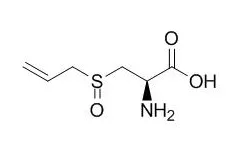| Description: |
Alliin has antiglycating potential , it offers protection against glucose or methyglyoxal induced glycation of superoxide dismutase, hence is expected to have therapeutic potential in the prevention of glycation-mediated diabetic complications. Alliin has anti-inflammatory activity, it protects against Lipopolysaccharides (LPS)-induced acute lung injury (ALI) by activating PPARγ, which subsequently inhibits LPS-induced NF-κB activation and inflammatory response; alliin has an inhibitory effect in osteoclasteogenesis with a dose-dependent manner via blocking the c-Fos-NFATc1 signaling pathway, it could be a potential therapeutic agent in the treatment of osteoporosis. Alliin and sabinene have detectable levels of antimicrobial activity. |
| In vitro: |
| Int J Mol Sci. 2016 Sep 20;17(9). pii: E1516. | | Alliin Attenuated RANKL-Induced Osteoclastogenesis by Scavenging Reactive Oxygen Species through Inhibiting Nox1.[Pubmed: 27657047] | The healthy skeleton requires a perfect coordination of the formation and degradation of bone. Metabolic bone disease like osteoporosis is resulted from the imbalance of bone formation and/or bone resorption. Osteoporosis also reflects lower level of bone matrix, which is contributed by up-regulated osteoclast-mediated bone resorption. It is reported that monocytes/macrophage progenitor cells or either hematopoietic stem cells (HSCs) gave rise to multinucleated osteoclasts. Thus, inhibition of osteoclastic bone resorption generally seems to be a predominant therapy for treating osteoporosis. Recently, more and more natural compounds have been discovered, which have the ability of inhibiting osteoclast differentiation and fusion. Alliin (S-allyl-l-cysteine sulfoxides, SACSO) is the major component of aged garlic extract (AGE), bearing broad-spectrum natural antioxidant properties. However, its effects on bone health have not yet been explored.
METHODS AND RESULTS:
Hence, we designed the current study to explore its effects and role in receptor activator of nuclear factor-κB ligand (RANKL)-induced osteoclast fusion and differentiation. It was revealed that Alliin had an inhibitory effect in osteoclasteogenesis with a dose-dependent manner via blocking the c-Fos-NFATc1 signaling pathway. In addition, Alliin decreased the generation of reactive oxygen species (ROS) and down-regulated the expression of NADPH oxidase 1 (Nox1).
METHODS AND RESULTS:
The overall results revealed that Alliin could be a potential therapeutic agent in the treatment of osteoporosis. | | J Ethnopharmacol. 2017 May 5;203:171-181. | | Antibacterial activity of medicinal plants from The Physicians of Myddvai, a 14th century Welsh medical manuscript.[Pubmed: 28344030 ] | Antimicrobial drug resistance is a growing threat to global public health. Historical records and herbal texts relating to traditional Celtic medicine indicate an extensive pharmacopeia of plants for treating infections likely caused by microbes. However, a major barrier for successful integration of these remedies into mainstream practice is the current lack of accurate interpretation and scientific validation.
METHODS AND RESULTS:
We investigated the flora of the Isle of Arran, Scotland, via in situ targeted screening of 83 out of 138 plants identified in Meddygion Myddvai (a 14th century Welsh manuscript) to treat conditions related to microbial infections, and an additional 18 plants from modern ethnobotanical knowledge on the island (Scottish School of Herbal Medicine). In a follow-up proof-of-concept study, bioassay-guided fractionation was performed to identify bioactive constituents from two high scoring hits that inhibited Staphylococcus aureus (Gram-positive) and Escherichia coli (Gram-negative) bacterial growth.
67 historical plants (80.7%) and 14 modern plants (77.8%) were found to have detectable levels of antimicrobial activity when tested using Mobile Discovery kits, with human saliva as a source of bacteria for screening. Sabinene, a natural bicyclic monoterpene from juniper "berries" (Juniperus communis L.) and Alliin, a natural sulfoxide from garlic cloves (Allium sativum L.), were isolated and confirmed as primary antibacterial leads.
CONCLUSIONS:
Using historical medical sources such as those associated with traditional Celtic medicine to guide rigorous, evidence-based scientific investigation, provides additional leads for new and alternative bioactive molecules for combating bacterial diseases. |
|






 Cell. 2018 Jan 11;172(1-2):249-261.e12. doi: 10.1016/j.cell.2017.12.019.IF=36.216(2019)
Cell. 2018 Jan 11;172(1-2):249-261.e12. doi: 10.1016/j.cell.2017.12.019.IF=36.216(2019) Cell Metab. 2020 Mar 3;31(3):534-548.e5. doi: 10.1016/j.cmet.2020.01.002.IF=22.415(2019)
Cell Metab. 2020 Mar 3;31(3):534-548.e5. doi: 10.1016/j.cmet.2020.01.002.IF=22.415(2019) Mol Cell. 2017 Nov 16;68(4):673-685.e6. doi: 10.1016/j.molcel.2017.10.022.IF=14.548(2019)
Mol Cell. 2017 Nov 16;68(4):673-685.e6. doi: 10.1016/j.molcel.2017.10.022.IF=14.548(2019)